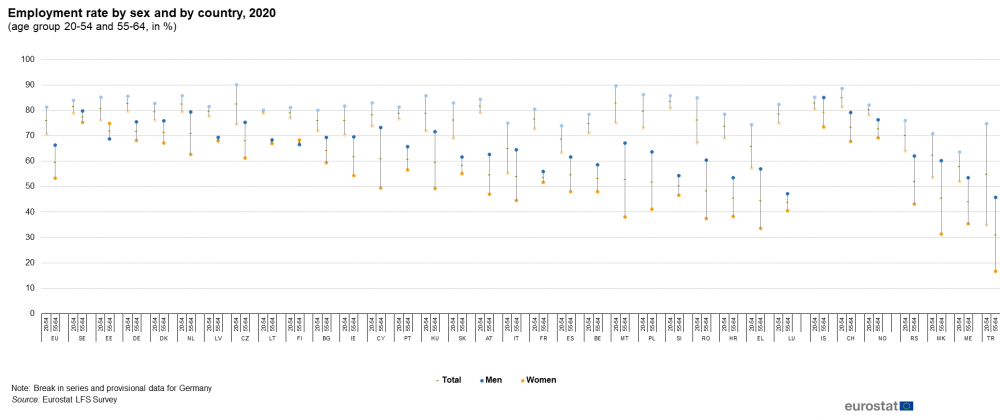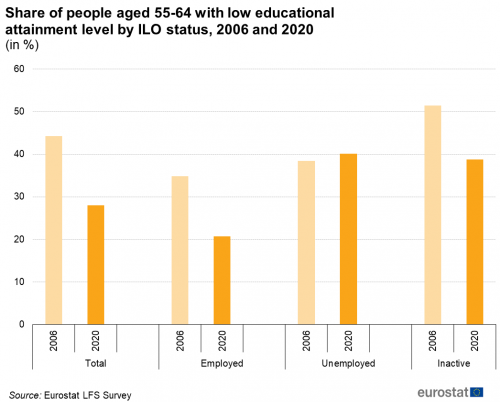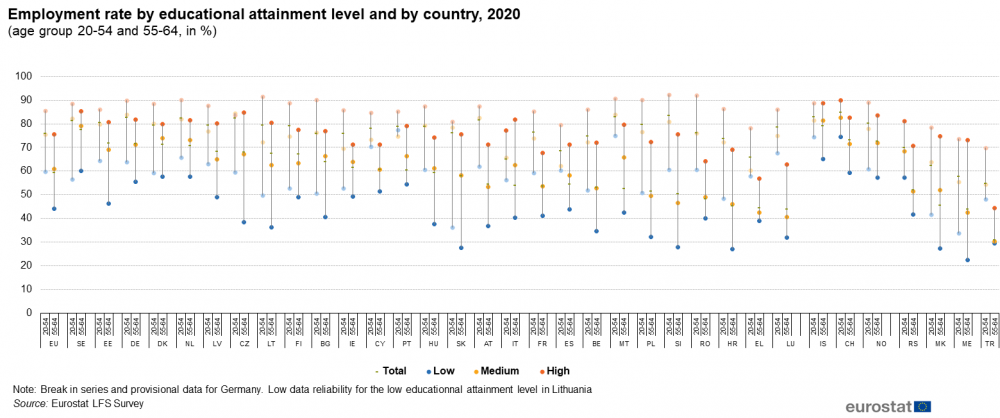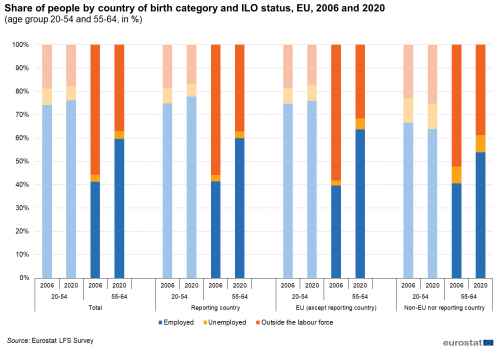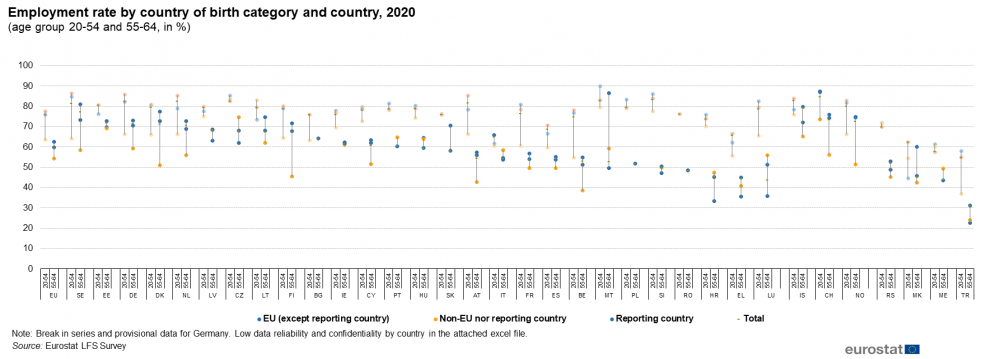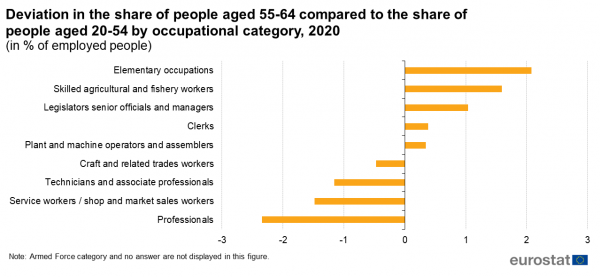Archive:Main differences between older and younger people on the EU labour market - statistics
Data extracted in Month YYYY
Planned article update: Month YYYY
Highlights
Tweet Text
Tweet Text
In the European Union, the last two decades have been marked by a steady increase in the employment of people aged 55-64 years. In all Member States, the global trend shows that people remain longer in employment, pushing back the age of retirement. Even the COVID-19 pandemic seems to have spared them so far from mass losses, leaving the employment rate of people aged 55-64 less fluctuant in 2020 than for younger people. To illustrate simply this development, in 2006, around four in 10 persons aged 55-64 were still employed in the European Union against six in 10 in 2020.
This article reports on the significance of this change between the years 2006 and 2020 but mainly focuses on the differences between younger people (20-54 years) and older people (55-64 years) in 2020 and attempts to answer the question: do the older worker have the same profile than younger people, in terms of gender, educational attainment level, country of birth and occupational category? It provides an analysis at EU level and at national level showing all EU Member States as well as EFTA and Candidate countries and is based on the annual data from the European Union Labour Force Survey (EU-LFS).
Full article
Focus on gender
Figure 1 examines the differences at EU level between people aged 20-54 and 55-64 in regards to the labour market, with a focus on gender. Looking at the total 20-54 years old population is visible that the rate of employed people increased by 2.0 percentage points from 2006 to 2020. This was accompanied by around 1.0 p.p. decrease in both the proportion of unemployed and those outside the labour force aged 20-54 over the same time span. On the other hand, the proportion of employed people among the age group 55-64 grew by 18.4 p.p. from 2006 to 2020, i.e. this age group had a much stronger increase in comparison with the younger representatives of the employed population. The increase in the employment rate for people aged 55-64 was followed by a decrease of 18.7 p.p. in the share of people outside the labour force and a slight increase, of 0.3 p.p., in those who were unemployed in the 15 years period from 2006 to 2020.
Accounting for gender, one can observe that the labour market situation for men aged 20-54 remained relatively stable between 2006 and 2020, with the largest change between these two years being in the share of people outside the labour force, which increased by 1.1 p.p. Women at that age had slightly more pronounced difference between 2006 and 2020 regarding the labour market situation; the share of employment in this sub-population increased by 4.3 p.p., while the share of unemployed and those outside the labour force decreased by -1.2 p.p. and -3.1 p.p., respectively. In contrast, women aged 55-64 had a 20.8 p.p. increase in the share of employment, 21.3 p.p. reduction in the share of those outside the labour force and 0.5 p.p. increase in the share of unemployed from 2006 to 2020. Men in the age group 55-64 experienced smaller changes in comparison with women at the same age, however, the sift was still significantly larger than for men aged 20-54. From 2006 to 2020, considering the age group 55-64, the male employed population increased by 15.9 p.p., the decrease in the share of men outside the labour force had exactly the same size (15.9 p.p.), while the share of unemployed remained stable over that period.
Despite the much more pronounced increase between 2006 and 2020 in the employment rate for people aged 55-64 in comparison with those aged 20-54, those two shares could not even out. In 2020, 76.2 % of people aged 20-54 were employed in the EU. With 59.6 %, the equivalent share for the older population, i.e. those aged 55-64, was still significantly smaller. Among the younger men, aged 20-54, 81.4 % were employed, compared with 66.2 % for the older male population. Although the employment rate for women in both age groups (20-54 and 55-64) was smaller than men’s, the same pattern can be witnessed: larger share for the younger age group in comparison with the older (70.8 % versus 53.4 %).
In all EU Member States in 2020, the employment rate for people aged 20-54 was larger than for people aged 54-64 (see Figure 2). Nevertheless, the generational gap varied a lot: from less than 10 p.p. in Estonia (8.8 p.p.), Denmark (8.2 p.p.) and Sweden (4.0 p.p.) to more than 30 p.p. in Malta (30.2 p.p.), Slovenia (33.1 p.p.) and Luxembourg (34.8 p.p.). In addition, the largest employment rate for people aged 55-64 was recorded namely in Sweden (77.6 %), Estonia (72.0 %) and Denmark (71.4 %). Germany, with 71.8 %, also had one of the largest employment rates for the age group 55-64. In contrast, Luxembourg registered the lowest employment rate in the EU for people in that age group - 44.0 %. In Romania, Croatia and Greece, also less than 50 % of the total population aged 55-64 were employed. Higher employment rates were found for the age group 20-54 in both ends of the scale, ranging from 83.6 % in Slovenia, 83.1 % in Malta and 82.8 % in Germany to 68.9 % in Spain, 66.0 % in Greece and 65.2 % in Italy.
Another relevant finding is that the gender gap in employment appears to be larger among people aged 55-64 than among those aged 20-54. In the age group 20-54, in all Member states was recorded larger employment rate for men than for women, and the gap reached 17.0 p.p. in Greece, 17.7 p.p. in Romania and 19.7 p.p. in Italy. On the other hand, in 25 out of the 27 EU Member States, the male’s employment rate surpassed female’s in the age group 55-64, and the gap exceeded 20 p.p. in Hungary (22.4 p.p.), Poland (22.6 p.p.), Romania (22.9 p.p.), Greece (23.4 p.p.), Cyprus (23.9 p.p.) and Malta (29.1 p.p.). Finland and Estonia were the only EU countries with a larger employment rate for women than for men in the age group 55-64 (gender gaps of 1.8 p.p. and 6.1 p.p. respectively for those two countries).
Focus on education
At EU level, the share of people with a low level of education among the total employed population aged 55-64 decreased significantly from 2006 to 2020, from 34.9 % to 20.7 % (see Figure 3). This share among those outside the labour force was larger than among the employed population; however, it also had a significant decrease for the same period - from 51.5 % to 38.7 %. The only group of people in terms of labour market status, which saw an increase in the share of people with a low level of education was that of unemployed; among the total unemployed people aged 55-64, 38.4 % were with low education in 2006, and 40.1 % in 2020.
Figure 4 reveals that at EU level people aged 55-64 needed a level of education further to reach a similar level of employability as those aged 20-54. In 2020, the employment rate for older people (aged 55-64) with a medium level of education was 60.9 %, similar to the rate for younger people (aged 20-54) with low education, which was 59.9 %. Analogically, older people with a high level of education had a similar employment rate as young people with medium education (75.6 % compared with 75.7 %). Furthermore, considering the educational levels separately, younger people had a significantly higher employment rate than the older generation in all the three levels shown in Figure 4. Precisely, the rate in 2020 for people aged 20-54 was higher than the rate for those aged 55-64 with 15.8 p.p., 14.8 p.p. and 10.1 p.p., respectively for the population with a low, medium and high level of education.
In terms of the employed population, the number of employed people in 2020, regardless of education level, has increased significantly since 2006. Employment rates among people with a low level of education increased by 11.7 % in 2020 compared to 2006, (2006: 32.7 % to 2020: 44.4 %). Among people with a medium level of education, the increase is 18.6 %. In 2006, the figure was 42.3 %, but by 2020, it had risen to 60.9 %. We are also seeing an increase in indicators in the sector of people with a high level of education. The difference is 13.3 % in favour of 2020.
This graph shows that the level of education has increased significantly among people aged 55 to 64. The point of this is demonstrated by data showing that in 2006, 44.9 % of people had a low level of education, but by 2020, this figure has dropped to 29.0 %. The proportion of people with a medium level of education has risen from 38.5 % in 2006 to 47.2 % in 2020. The proportion of people with a high level of education increased by 7.2 % from 16.6 % in 2006 to 23.8 % in 2020.
The number of people with a low level of education has decreased by 14.0 % among the employed population. Also, among employed people, the number of people with a medium and high level of education has increased. (8.8 %; 5.2 % respectively). According to the data presented above, a significantly higher proportion of employed people have a higher level of education in 2020 than in 2006.
The number of people with a medium or high education among those who are inactive has increased (8.5 % and 3.8 %, respectively), which may indicate an early retirement. However, for people with a low education level, this indicator has decreased from 52.0 % in 2006 to 39.7 % in 2020, indicating that more people with a low education may remain in the labour market.
In 2006, the number of men with a low level of education was much lower compared to women with a low level of education: 42.8 % for men and 57.2 % for women. By 2020, the number of women with low education began to fall, while the number of men with low education began to grow, and this difference was 7.6 % (46.2 % for men and 53.8 % for women) comparing to 14.4 % in 2006.
In terms of people with a medium level of education, men accounted for 51.2 % and women accounted for 48.8 % in 2006, but by 2020, the situation had shifted almost opposite, with women taking the lead.
The most interesting sector is the sector for people with a high level of education. In 2006, men with a high level of education accounted for 56.8 %, while women accounted for only 43.2 %. By 2020, the situation had drastically changed, with men accounting for 49.8 % and women accounting for 50.2 %.
Focus on country of birth
Focus on professional category
Looking at the distribution people aged 55-64, it appear that Professionals 19.9 Technicians and associate professionals 15.8 Service workers / shop and market sales workers 14.5 Craft and related trades workers 11.1
Source data for tables and graphs
Data sources
<description of data sources, survey and data availability (completeness, recency) and limitations>
Context
<context of data collection and statistical results: policy background, uses of data>
Direct access to
Main tables
- Title(s) of second level folder (if any)
- Title(s) of third level folder (if any)
Database
- Title(s) of second level folder (if any)
- Title(s) of third level folder (if any)
Dedicated section
Publications
Publications in Statistics Explained (either online publications or Statistical articles) should be in 'See also' above
Methodology
<link to ESMS file, methodological publications, survey manuals, etc.>
- Crime and criminal justice (ESMS metadata file — crim_esms)
- Title of the publication
Legislation
- Use Eur-Lex icon on the ribbon tool at the top of the statistical article to enter the year and reference of your regulation or directive.
- See example of what should be issued hereafter
- Regulation (EU) No 1013/2016
Visualisations
- Regional Statistics Illustrated - select statistical domain 'xxx' (= Agriculture, Economy, Education, Health, Information society, Labour market, Population, Science and technology, Tourism or Transport) (top right)
External links
Notes
<footnote text will be automatically inserted if reference tags are used in article content text (use reference icon on ribbon)>
[[Category:<Subtheme category name(s)>|Name of the statistical article]] [[Category:<Statistical article>|Name of the statistical article]]

